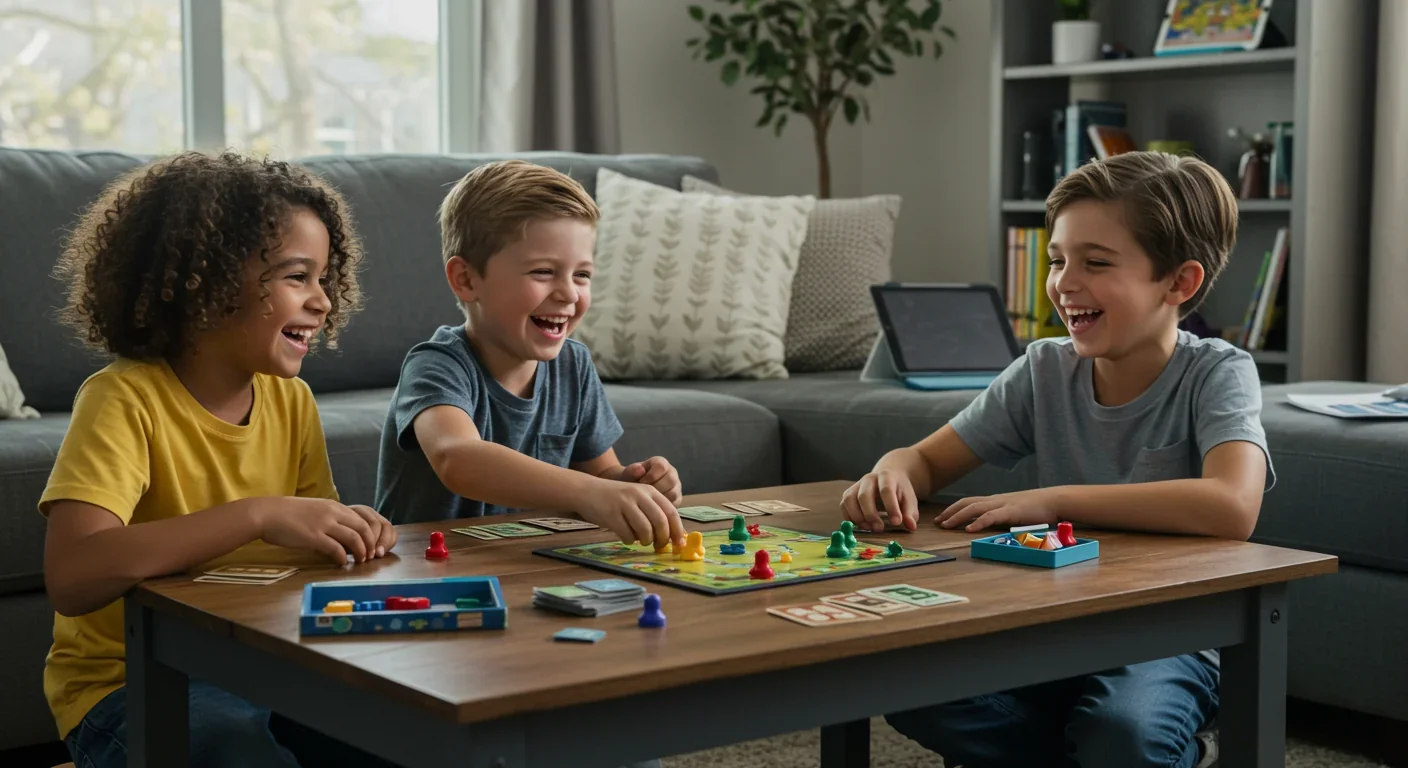Epigenetic Clocks Predict Disease 30 Years Early

TL;DR: Digital screens are fundamentally rewiring children's developing brains through dopamine-driven reward circuits, causing measurable declines in executive function, attention spans, and white matter organization. Parents can mitigate harm through age-appropriate limits, screen-free zones, active engagement, and prioritizing physical activity—but the full impact won't be known for decades.

By 2030, researchers predict that over 80% of children will own their first device before age three. What's happening in neuroscience labs right now reveals that this digital immersion isn't just changing behavior—it's fundamentally restructuring the developing brain. The consequences ripple through attention spans, empathy, and learning outcomes in ways we're only beginning to understand.
When a child swipes through content on a tablet, something profound happens in their neural architecture. The brain's reward system—centered in regions like the ventral tegmental area, nucleus accumbens, and prefrontal cortex—floods with dopamine, the same neurotransmitter released during substance use. This isn't metaphor. It's measurable neurochemistry.
The mesolimbic dopamine system drives the perceived pleasure and reward experienced during gaming and scrolling. Each notification, level-up, or auto-playing video triggers a micro-reward that reinforces compulsive behavior patterns. Over time, the brain adapts, requiring more stimulation to achieve the same dopamine hit.
But the rewiring goes deeper than just reward circuits. Studies tracking young children have shown that higher amounts of screen time at an early age can hinder the development of executive functions—the cognitive abilities that govern planning, impulse control, and working memory. This is partly because engaging with screens often involves rapid, reward-based interactions that condition the brain to favor short-term gratification over more substantial, long-term goals.
Prolonged use of screens has also been correlated with decreased organization of the brain's white matter, which supports language and literacy. In one study, participants with more screen time performed less well on cognitive tests, suggesting that the structural integrity of neural pathways suffers under chronic digital exposure.
Thirty years ago, the average household had one television and perhaps a desktop computer shared among family members. Screen time was finite, bounded by bedtime and family dinners. The introduction of smartphones in 2007 changed everything.
The printing press democratized information over centuries. The internet did it in decades. But mobile devices compressed that transformation into years, putting infinite content in every pocket. Three in five children under 13 now own a device, and most kids start using one before age three.
This rapid adoption outpaced our understanding of its effects. Unlike previous media revolutions, digital platforms engineer engagement through algorithms designed to maximize time spent. Variable reward schedules—the same mechanism that makes slot machines addictive—keep users scrolling. And children, whose prefrontal cortex won't fully mature until their mid-twenties, are particularly vulnerable.
Historical precedent offers some guidance. When television became widespread in the 1950s, parents worried about "couch potatoes" and declining literacy. Research eventually revealed that content quality mattered more than raw screen time. Educational programming could enhance learning; mindless consumption harmed it. The same principle applies today, but with a crucial difference: digital platforms actively resist passive consumption. They demand interaction, fragmenting attention in ways television never did.
Understanding how screens rewire the developing brain requires grasping a few key concepts about neural plasticity. The human brain, especially during childhood, is extraordinarily adaptable. Neural pathways strengthen with use and weaken with neglect—a principle called Hebbian learning, often summarized as "neurons that fire together, wire together."
Digital environments exploit this plasticity. When a child experiences the rapid feedback loops of a video game or social media feed, neural circuits dedicated to quick reward processing become dominant. Meanwhile, the prefrontal cortex—deeply interconnected with other brain regions, forming a complex network of neural highways—receives less practice in the sustained attention and delayed gratification required for complex problem-solving.
The result? Executive function declines. Quick hits of news, info, and entertainment diminish neural networks we need to plan and solve problems. Attention spans shorten. Impulse control weakens. These aren't moral failings; they're predictable adaptations to an environment optimized for distraction.
Functional MRI studies reveal another concern: excessive screen use correlates with altered connectivity in brain regions responsible for memory, attention, and emotional regulation. The hippocampus, critical for forming long-term memories, shows reduced activity in heavy screen users. The amygdala, which processes emotions, becomes hyperactive, contributing to increased anxiety and emotional volatility.
Perhaps most troubling, research on Internet Gaming Disorder—officially classified in the DSM-5—demonstrates that digital addiction exhibits compulsive behavior, loss of self-control, and withdrawal symptoms when stopped, just like other types of addiction. The brain literally treats screen deprivation as a threat.

The implications extend far beyond individual children. We're witnessing the emergence of the first generation raised in an always-on digital ecosystem, and the societal impacts are profound.
In classrooms, teachers report declining attention spans and increased difficulty with sustained focus. Students accustomed to bite-sized content struggle with complex texts that require deep engagement. Group work reveals deficits in empathy and social cognition—skills traditionally developed through face-to-face interaction.
The workplace is already feeling the effects. Employers note that young workers often excel at multitasking and rapid information processing but struggle with projects requiring sustained concentration. The neural trade-off becomes apparent: gains in some cognitive domains come at the expense of others.
Family dynamics have shifted too. Over half (51%) of American parents let their children spend more than 3 hours per day engaging with digital devices, yet many feel guilty about it. The paradox is that parents themselves are often equally tethered to screens, modeling the behavior they wish to curtail.
Digital literacy—once seen as purely beneficial—now carries hidden costs. A generation fluent in navigating apps and platforms may lack the deeper cognitive architectures needed for innovation and critical thinking. The way we work, learn, and communicate is fundamentally changing, and not all changes trend positive.
Yet technology isn't inherently harmful. The same devices that fragment attention can also expand learning opportunities. Educational apps, when used intentionally, provide personalized learning pathways impossible in traditional classrooms.
Video games that incorporate physical activity combine the engagement of digital platforms with the health benefits of movement. Exergames like Ring Fit Adventure or Beat Saber offer proof that screen time doesn't have to mean sedentary time.
Virtual reality opens new possibilities for experiential learning. Students can explore the Colosseum in ancient Rome, dissect a virtual frog, or practice public speaking in a simulated auditorium—all from their classroom. For children with learning disabilities or social anxiety, these tools provide low-stakes environments to build skills.
Social connection through screens has enabled friendships across continents and provided lifelines for isolated teens. During the COVID-19 pandemic, digital platforms allowed education to continue when in-person learning was impossible. For better or worse, screens kept society functioning.
The key is intentionality. When parents engage with content alongside their children—asking questions, discussing themes, connecting digital content to real-world experiences—screen time transforms from passive consumption into an interactive learning opportunity. The medium matters less than how it's used.
The risks, however, demand serious attention. Addiction to video games can result in social isolation, a decline in physical activity, and disregard for significant obligations. Unlike substance addictions, gaming addiction is rarely recognized as harmful because it's a socially accepted pastime, which delays detection and intervention.
Mental health consequences mount. Studies reveal that daily limits of 4+ hours of TV are linked to a higher risk of negative outcomes, including anxiety, depression, and cognitive decline. When participants replaced 30 minutes of TV viewing with physical activity, their risk for dementia and depression decreased substantially.
Sleep disruption amplifies these effects. Blue light from screens suppresses melatonin production, delaying sleep onset. But the psychological arousal from engaging content proves even more disruptive. Children scrolling through social media or playing intense games before bed experience heightened alertness that persists long after the screen goes dark.
The digital divide creates two separate realities. Affluent families increasingly limit their children's screen time and prioritize hands-on learning, while less privileged children often have unlimited access to devices but limited guidance on healthy use. This compounds existing inequalities, creating divergent developmental trajectories based on socioeconomic status.
Perhaps most insidious is the erosion of boredom. Children accustomed to constant stimulation never develop the tolerance for unstimulated time that breeds creativity. Innovation often emerges from idle moments—daydreaming, tinkering, wondering. When every spare second gets filled with content consumption, the mental space for original thought disappears.

Different cultures approach digital childhood with varying philosophies. In South Korea, where gaming culture is deeply embedded, the government has implemented "shutdown laws" preventing children under 16 from accessing online games between midnight and 6 a.m. Internet addiction is classified as a public health crisis, with treatment centers nationwide.
Japan has taken a different approach, emphasizing collective responsibility rather than individual restriction. Schools incorporate digital citizenship curricula that teach mindful technology use alongside traditional academics. The goal isn't abstinence but balance.
In contrast, Silicon Valley presents a paradox: the engineers designing addictive platforms often send their own children to device-free schools. Waldorf schools in California—popular among tech executives—ban screens entirely through eighth grade, prioritizing hands-on learning and social-emotional development. This reveals a troubling awareness among creators of these technologies about their potential harms.
Northern European countries like Sweden and Finland integrate technology thoughtfully into education while maintaining strong outdoor education traditions. Children learn coding in school but also spend substantial time in nature—a combination that appears to balance digital fluency with broader cognitive development.
Developing nations face different challenges. As smartphone adoption accelerates in regions with limited digital literacy infrastructure, children gain access to devices without the educational scaffolding to use them wisely. International cooperation remains minimal, with most policy developed in isolation rather than through shared learning.
So what can parents, educators, and policymakers actually do? The evidence points to several actionable strategies.
Set age-appropriate limits. For infants under 18 months, avoid screen time except for video chatting. Toddlers (18-24 months) can watch high-quality programming with a parent. Preschoolers should be limited to 1-2 hours per day of educational content. School-age children benefit from consistent limits negotiated as a family.
Create screen-free zones. Bedrooms and dining areas should remain device-free, protecting sleep hygiene and family connection. Establishing these boundaries early makes them easier to maintain as children age.
Engage actively with content. Parental engagement transforms screen time from passive consumption into an interactive learning and bonding opportunity. Watch together, ask questions, extend lessons into offline activities.
Teach executive function explicitly. Give kids multi-step tasks that require setting a goal and planning the steps to reach it: not just chores, but tasks like shopping with a budget, planning and cooking a meal, or organizing a family event. These activities strengthen the neural networks that screen time undermines.
Model healthy behavior. Children imitate what they see. If parents are constantly on devices, no amount of rule-setting will be effective. Demonstrate the focused work, face-to-face conversation, and offline hobbies you want children to value.
Prioritize physical activity. Replacing even 30 minutes of screen time with movement significantly improves cognitive and emotional outcomes. Sports, outdoor play, and active games provide the dopamine hits that screens offer while building healthier neural pathways.
Foster real-world social skills. Arrange playdates, encourage extracurriculars, and create opportunities for unstructured socializing. The most important life skill to teach teens is empathy—something that develops through practice, not through screens.
Advocate for systemic change. Support policies that limit manipulative design features in children's apps, require transparency from platforms about engagement tactics, and fund research into long-term developmental impacts. This isn't a problem parents can solve alone.
The path forward requires acknowledging a difficult truth: we're conducting a massive, uncontrolled experiment on developing brains. The full results won't be clear for decades. But the early data suggests caution. Our children's neural architecture—and by extension, their capacity for attention, empathy, and deep thought—hangs in the balance.
The digital world isn't going away. But we can shape how it shapes us. That starts with understanding what's at stake, then acting with the urgency the science demands. Because rewiring a generation's brain isn't a side effect of progress—it's a choice we're making right now.

Recent breakthroughs in fusion technology—including 351,000-gauss magnetic fields, AI-driven plasma diagnostics, and net energy gain at the National Ignition Facility—are transforming fusion propulsion from science fiction to engineering frontier. Scientists now have a realistic pathway to accelerate spacecraft to 10% of light speed, enabling a 43-year journey to Alpha Centauri. While challenges remain in miniaturization, neutron management, and sustained operation, the physics barriers have ...

Epigenetic clocks measure DNA methylation patterns to calculate biological age, which predicts disease risk up to 30 years before symptoms appear. Landmark studies show that accelerated epigenetic aging forecasts cardiovascular disease, diabetes, and neurodegeneration with remarkable accuracy. Lifestyle interventions—Mediterranean diet, structured exercise, quality sleep, stress management—can measurably reverse biological aging, reducing epigenetic age by 1-2 years within months. Commercial ...

Data centers consumed 415 terawatt-hours of electricity in 2024 and will nearly double that by 2030, driven by AI's insatiable energy appetite. Despite tech giants' renewable pledges, actual emissions are up to 662% higher than reported due to accounting loopholes. A digital pollution tax—similar to Europe's carbon border tariff—could finally force the industry to invest in efficiency technologies like liquid cooling, waste heat recovery, and time-matched renewable power, transforming volunta...

Humans are hardwired to see invisible agents—gods, ghosts, conspiracies—thanks to the Hyperactive Agency Detection Device (HADD), an evolutionary survival mechanism that favored false alarms over fatal misses. This cognitive bias, rooted in brain regions like the temporoparietal junction and medial prefrontal cortex, generates religious beliefs, animistic worldviews, and conspiracy theories across all cultures. Understanding HADD doesn't eliminate belief, but it helps us recognize when our pa...

The bombardier beetle has perfected a chemical defense system that human engineers are still trying to replicate: a two-chamber micro-combustion engine that mixes hydroquinone and hydrogen peroxide to create explosive 100°C sprays at up to 500 pulses per second, aimed with 270-degree precision. This tiny insect's biochemical marvel is inspiring revolutionary technologies in aerospace propulsion, pharmaceutical delivery, and fire suppression. By 2030, beetle-inspired systems could position sat...

The U.S. faces a catastrophic care worker shortage driven by poverty-level wages, overwhelming burnout, and systemic undervaluation. With 99% of nursing homes hiring and 9.7 million openings projected by 2034, the crisis threatens patient safety, family stability, and economic productivity. Evidence-based solutions—wage reforms, streamlined training, technology integration, and policy enforcement—exist and work, but require sustained political will and cultural recognition that caregiving is ...

Every major AI model was trained on copyrighted text scraped without permission, triggering billion-dollar lawsuits and forcing a reckoning between innovation and creator rights. The future depends on finding balance between transformative AI development and fair compensation for the people whose work fuels it.